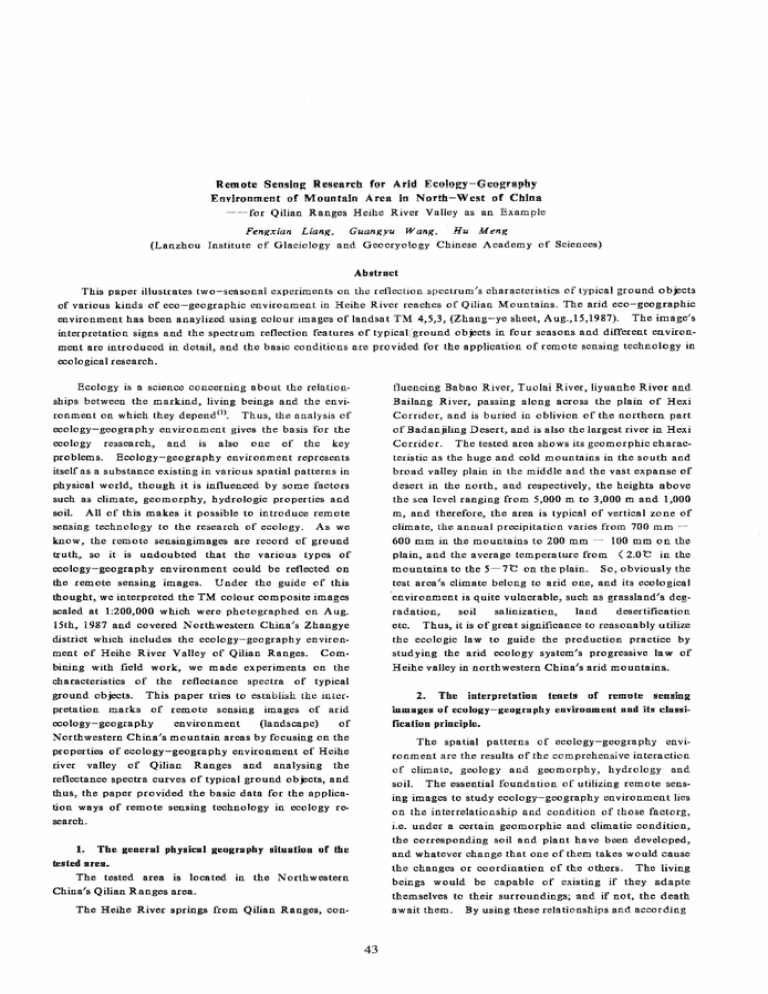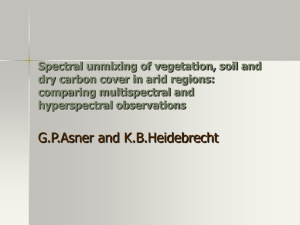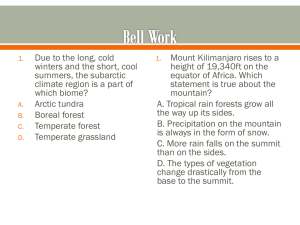Sensing Researcn for Arid Ecology-Geography Remote
advertisement

Remote Sensing Researcn for Arid Ecology-Geography
Environment of Mountain Area in North-West of China
--for Qilian Ranges Heihe River Valley as an Example
Fenf{xian
Lianf{,
Guangyu
Wang,
Hu
Meng
(Lanzhou Institute of Glaciology and Geocryology Chinese Academy of Sciences)
Abstract
This paper illustrates two-seasonal experiments on the reflection spectrum/s characteristic:!! of typical ground ob~cts
of various kinds of eeo-geographic environment in Reihe River reaches of Qilian Mountains. The arid eco-geographic
environment has been anaylized using colour images ef landsat TM 4,5,3, (Zhang-ye sheet, Aug.,15,1987). The image's
interpretation signs and the spectrum reflection features of typical/~round obje:cts in four seasons and different environment are introduced in detail, and the basic conditions are provided for the application of remote sensing technology in
ecological research.
Ecology is a science concerning about the relation·
ships between the markind, living beings and the en vi·
ronment on which they depend(l). Thus, the analysis of
ecology-geography environment gives the basis for the
ecology ressearch, and is also one of the key
problems. Ecology-geography environment represents
itself as a substance existing in various spatial patterns in
physical world, though it is influenced by some factors
such as climate, geomorphy, hydrologic properties and
soil. All of this makes it possible to introduce remote
sensing technology to the research of ecology. As we
know, the remote sensing images are record of ground
truth, so it is undoubted that the various types of
ecology-geography environment could be reflected on
the remote sensing images. Under the guide of this
thought, we interpreted the TM colour composite images
scaled at 1:200.000 which were photographed on Aug.
15th, 1981 and covered Northwestern China's Zhangye
district which includes the ecology-geography environment of Heihe River VaHey of Qilian Ranges. Combining with field work, we made experiments on the
characteristics of the reflectance spectra of typical
ground objects. This paper tries to estabiish. the mter·
pretation marks of remote sensing images of arid
ecology-geography
environment
(landscape)
of
Northwestern China's mountain areas by focusing on the
properties of ecology-geography environment of Heihe
river valley of Qilian Ranges and analysing the
reflectance spectra curves of typical ground objects, and
thus, the paper provided the basic data for the application ways of remote sensing technology in ecology research.
1.
Buencing Babao River. Tuolai River, liyuanhe River and
Bailang River, passing along across the plain of Hexi
Corridor, and is buried in oblivion of the northern part
of Badanjiling Desert. and is also the largest river in Hexi
Corridor. The tested area shows its geomorphic characteristic as the huge and cold. mountains in the south and
broad valley plain in the middle and the vast expanse of
desert in the north, and respectively, the heights above
the sea level ranging from 5,000 m to 3,000 m and 1,000
m, and therefore, the area is typical of vertical zone of
climate, the annual precipitation varies from 700 mm -600 mm in the mountains to 200 mm -- 100 mm en the
plain, and the average temperature from (2.0t: in the
mountains to the 5-Tt on the plain.. So, obviously the
test area's climate belong to arid one, and its ecological
'environment is quite vulnerable~ such as grassland's degradation,
soil
salinization,
land
desertification
etc. Thus, it is of great significance to reasonably utilize
the ecologic law to guide the production practice by
studying the arid ecology system's progressive law of
Heihe valley in northwestern China's arid mountains.
2. The interpretation tenets of remote semlin2
mmages of ecology-geography environment snd its classification principle.
The spatial patterns of ecology-geography envi·
ronment are the results of the comprehensive interaction
of climate, geology and geomorphy, hydrology and
soiL The essential foundation of utilizing remote sensing images to study ecology-geography environment lies
on the interrelationship and condition of those factorg,
i.e. under a certain geomorphic and climatic condition,
the corresponding soil and plant have been developed,
and whatever change that one of them takes would cause
the changes or coordination of the others. The living
beings would be capable of existing if they ada pte
themselves to their surroundings; and if not, the death
await them. By using these relationships and according
The general physical geography situation of the
tested sres.
The tested area is located in the Northwestern
China's Qilian Ranges area.
The Heihe River springs from Qilian Ranges, con·
43
to the color density ratio and stripe of remote sensing
images, we can directly deduce certain ecology-geogra.
phy environment, this is the very principle of interpreta.
tion of rem ate sensing images of ecology-geography en·
vironment. Heihe River vaHey belong to high mountain
ecology system of land ecology system. as stated above,
Qilian Ranges' ecology-geography environment is typi.
cal of obviously vertical varification, this is because of its
geomorphic features which determines different temperatures from top of the mountains to its foot, different precipitation, air humidity, cloud amount, wind velocity,
sun shine etc.
In view of influence factors of ecology-geography
environment, geomorphy is a decisive factor which determines topography and foundmenlal patterns of physi·
cal environment, further more, the plant and soil are not
only the indicators of water and heat quantity, but also
the main components of ecology-geography environment. There four, in the classification of ecology-geog.
raphy environment, and in regard to the geomorphic
types such as super-high mountain, high mountain, me·
dium-high mountain, low mountain, river vaHey and
plain, we devided them as the ht classification unit and
the dividing of the 2nd classification mainly depends on
the varifications of plant and soil, thus, every
geomorphic unit is a ecology systems, in which the corre·
sponding living beings live.
There are various geomorphy types as well as its
ecology-geography environment which have been
moulded by some factors such as glacier, cold and forzen
weathering, wind and rain ravage, and dry corroding.
3.
blocks cf clouds_ The glacier is in strip or tcngue-like
shape; if the surface of glacier is melting, then it is in p8le
blue and in the mean while it gives out a little of stereo·
8copic fceding.
Th.e cold-desert strips ilcpresenL themselves on
rc~
mote 8ensing image~ u bllJegn~y col(1[" and are distrib·
uted in the form of circular around the glacier-s.rrow
belt, the boundary between them is pretty obvious owing
to their constituent matter such as ice moraine and rocky
waste. Because of rare piants existing there, it is alm08t
impossible to lock for any red strip or print on the re·
mote sensing images.
2j .dlgh mountain district
The ecology-geography environment of the district
mainly
~..onnsists
of
high
mountain
grassy
marshland. Located at elevation of 3,600-- 3,900 ill on
gentle slope, the plants of the district primarily consists
of wormwood, combin.ed with a little bryopbte, and
densely growes with its covering rate of 80-- 90% or
more; on some part of the ground with considerable
hummidity growes marsh grass, and here is used mainly
as summer grazing land. Its soil layer is comparatively
thin and is composed of ice-water tluid deposites; soil
belong to high mountain meadow soil. The district belong to multiyear frozen soil of island-like, and the lower
line of the soil is 3,500 m beneath the ground
surface. Bacause this kind of ecologic environment is
quite vuluerable, any physical factor(e.x. the transition of
climate from cold to warm one) and humman interferences(e.x. over loading cattle on pasture) could cause to
some extent the changes of ecology environment, because
both of the two factors could probably induce the degra·
dation process of frozen soil and thus deepen the depth
of the seasonal melting layer~ permeating downwards of
ground wat€~r, 8.S a resu.lt, there is not enough water for
plant's root, and finally, a series of ecological conditions
go from bad to worse, such as degradation of pasture
land, desertification of land etc. It is quite slow fLIt'
land-like frozen soil to recover its original state from its
damaged state because the c.old climate and low temperature stand as a big obstacle of natural progressive process
of vegetation. Therefore, much attention should be
paid for the scientific utilization of it and the protection
for en vironment.
In contrasted with super high mcuntain district, this
district's vegetation covering rate is considerably larger.
High mountain meadow and marsh meadow show
themselves in bright red color on remote sensing images,
and owing to the large covering rate of plants, the red
blocks of it on the images feels smooth and fine just like
red carpet, and thus its boundary with the abo ve district
is quite clear, and is the upper limit line of high mountain
meadow.
The basic characteristics of ecololty-geography
environment of test area and their reflection on the remote
sensin~ ima~es.
1) Super-high mountain district.
The ecology-geography environment distributed in
super-high mountain district include two types: glacier
and constant existing snow belt, and cold desert
belt. The former one is located 4,200-- 4,500 m above
sea level its annual average temperature is between --6 t
-- -8 t; with abundant annual precipitation of 600-700
mm, half of which is in solid state. Its glacier and con·
stant existing snow belt are well developed and the to ps
of the mountains are covered with white snow through.
out the year. The ice and snow melting water is the main
source of ground water. The latter are scattered 3,900
- 4,200 m above sea level with cold climate and strong
cold and frozen weathering process. Its zenith plants
mainly consists of scattered blocks of bryophyte, lichen
and other cuslio-like plants; its ground matter consists
of moraine and rocky waste, it soil belong to cold-desert
one. The frozen earth layers are popluelar here and
stable owing to high ith elevation, cold climate, hard
ecological conditions and little human influence.
The glacier and constant existing snow belt and cold
desert belt are quite clear on TM images, especially the
snow cover which is in white block form and has a bit of
3} Medium-high mountain district
The ecology-geography environment of this di8trict
is much complicated. Influened by particIJiar topography such as slope and its orientation, and iis main
land-scapes including meadow bushes, meadow
44
grassland, mountainous grasslang. meadow bushes are
mainly scattered at 3,400- 3,700 m above sea level on
sunbackward slope of mountain. The sunbackward
slope poccess ideal water supply and hummidity condition, this results in luxmg growth of bushes, high moun.
tain willow and bush cinquefoiL Its soil belong to
bushes meadow soil. The sunwards mountain slope has
good beam radiation, and is comparably dry, its vegeta.
tion mainly conrists of bryophyte, weilincai, their covering rate is up to 60- 80%; the soil belong to mountain
tBhernosem, and is typical of meadow grassland, on reo
mote sensing images, sunbackwards slope is in dark red
blocks; sunwards slope is in bright red. Abont 2,4003,400 m below it is forest-bush and mountain pasture
landscape, with the former one distributed on
sunbackwards slope and the latter one on sun wards slope
as well as on gentle hill ground. The forest mainly develops along QiIian mountain and Longshou mountain
which is in the northern part of the test area; because of
its moderate precipitation, about 300- 500 mm, the forest mainly consists of arbor, and the main kind is
Qinghai dragon spruce and Qman one, both of them be.
long to ever-green-needle-ieaf woods. Beneath the
woods, bushes are luxury on the taupe cinnamon
soil. This kind of landscape could be observed along
the Binggou of Qman county as well as in Longshou hm
of Dongda mountain. The sunwards slope show the
mountain grassland scene developed mainly at 2,400--2,600 m above sea level, with precipitation ranging between 100- 200 mm and dry climate and under-devt~I.
oped plants which primarily consists of arid-perssistant
plants such as stipa, prairie and sheatgrass and their covering rate is about 50%; the soil is mountains
castanozem.
ment becomes one of the most urgent problems.
4) HiHs district
The hilly land work its elevation of no more than
2,4000 is occupied by landscape of desert grass land. It
is typical of strong dry-denudation, sparse plants COY"
ering which include various arid-perssistant plants such
as desert-oriented stipa, sh.aft flower stipa, gtml,~
synclphalon; Then covering rate is about 10-20 % • The ground matter is coarse, and the soils belong
to mountain sierozem, Much of this kind of landscape is
in grey-yellow colour, and some others are in red-yeliow
colour.
The ecological environment of hills belongs to desert
pasture one, and its productivity is quite poor owing to
arid land and low temperature throughout the year, so
apart from a little of it could be used as grazing land.
much of it has barely been. changed by humman. beings.
5) Plain beside mountain foot
Th.is kind of plain. was formed by movement of
runoff or snow and ice melting water current which
brought iarge amount of rocky waste to be deposited at
the foot of the mountain. This district is broad and
vast, and the layers of the depositions are quite regular
considering their constituent matter~ e.x. downwards
from foot of the mountain the particulator matter turned
from coarse to fine particle, and formed a series of arid,
semi-arid desert ecology system such as rock matter,
sand matter and earth matter. Here the vegetation are
rare except the arid-persistent plants such as harmel,
syncephalon.
The rocky matter and sand matter based desert COyers mainly on fluvial splays and broad dried river bed,
and the most of them show typical rocky matter based
desert which can be remarkably retlected in form of
blue-grey splays on remote sensing images, and the more
rocky matter the more density of blue color it has.
Sand matter based or earth matter based desert are
mainly distributed in the middle and lower reaches of
modern rivers or in the middle and the lower part of
bread flood splays.
The ground surface is dry, and some of its Iower
land which is within the reach of subground water sho'N
the landscape of salty desert. The earth-sand matter
based desert is in white-light yellow-yenow colour on
remote sensing images, and further more, the finer the
earth is, the more salt it contains and become drier and
more pale color; altheuth salty desert is also in white col·
our, it is easy to be teHed from the former one because it
has salt halo and irregular dyeing patterns.
The water shortage and poor procu:;tiviry are the
two
characteristicses
of
vulnerable
desert
ecosystem. Because of drought and wind in addition to
sand matter deposition which is deep and porous, aU of
them constituted the poten-tial factors of inducing the
trend of desertificatien; and the ever farming and over
grazing of iand and the uncontrolled felling trees acceler-
On remote sensing images woods and bushes are in
dark-red strips or blocks, but the mountain pasture is in
light red and of less density owing to its poor covering
rate.
In the process of interpreting the land sea pes of
ecologic environment in medium-high mountains; much
more attention worth being paid to the possible confusion of images of meadow bushes and woods-bushes owing to the colour similarity between them. However,
this problem could be solved if we analyse their verical
zonality of plants as well as their elevation and slope
orientation Nevertheless. the best method is to make
contrastive analysis on multi-temporal remote sensing
images
and
therefore
acquire
satisfactory
results. Bacause the evergreen woods is popular in the
test area, they are also in red colm




